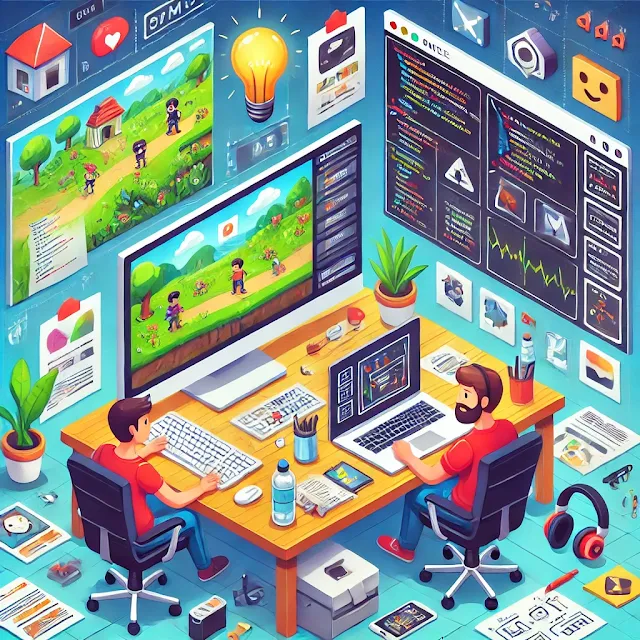How to Make a Mobile Game: A Step-by-Step Guide
Mobile games have become one of the most popular forms of entertainment today. Many people dream of creating their own mobile game but don’t know where to start. The good news is that making a mobile game is easier than ever, thanks to modern technology and tools. In this guide, we will explain the process in simple words, step by step, so you can understand how to create a mobile game from scratch.
Step 1: Come Up with an Idea
Every game starts with an idea. Before you begin creating a mobile game, you need to think of a fun and interesting concept. Your game idea should be simple enough for people to understand but unique enough to stand out.
How to Come Up with a Good Game Idea:
Think about your favorite games and what makes them fun.
Consider popular game genres like puzzle, action, adventure, and strategy.
Keep it simple—games like Flappy Bird and Subway Surfers are fun but not complicated.
Write down different ideas and pick the best one.
Step 2: Plan Your Game
Once you have an idea, you need to plan your game. This involves deciding how the game will look, work, and be played.
Things to Plan:
Game Mechanics: What are the rules? How does the game work?
Characters & Story: Who are the characters? Is there a storyline?
Graphics & Sound: What kind of visuals and sounds will the game have?
Game Levels: Will there be different levels or challenges?
Monetization: Will the game be free with ads, or will users pay to play?
Writing down these details will help you stay organized and focused.
Step 3: Choose the Right Tools
To create a mobile game, you need special software. There are many game development tools available, even for beginners.
Popular Game Development Tools:
Unity – A powerful tool for making 2D and 3D games.
Unreal Engine – Great for high-quality graphics.
Godot – A free and beginner-friendly option.
GameMaker Studio – Perfect for 2D games.
Construct – A drag-and-drop tool for non-programmers.
Each tool has different features, so choose the one that fits your needs best.
Step 4: Start Designing Your Game
Now it's time to start designing your game. This includes creating characters, backgrounds, and objects. If you are not good at drawing, you can use free assets from websites like OpenGameArt or buy assets from marketplaces like Unity Asset Store.
Important Game Design Elements:
User Interface (UI): Buttons, menus, and screens.
Character Design: How your characters look and move.
Environment: Backgrounds, buildings, and landscapes.
Sound Effects & Music: Background music and sound effects for actions.
Good design makes a game more enjoyable and easy to play.
Step 5: Coding Your Game
Coding is the process of writing instructions that tell the game what to do. Most game development tools have built-in coding languages.
Common Programming Languages for Mobile Games:
C# (for Unity)
C++ (for Unreal Engine)
GDScript (for Godot)
JavaScript (for some web-based games)
If you are new to coding, don’t worry. Many game engines offer tutorials to help you learn.
Step 6: Test Your Game
Once your game is built, you need to test it to make sure it works correctly. Testing helps you find and fix bugs (errors in the game).
How to Test Your Game:
Play the game yourself and look for problems.
Ask friends or family to test it.
Use debugging tools in your game engine.
Fix any bugs or issues before releasing the game.
Testing ensures your game is fun and runs smoothly on different devices.
Step 7: Publish Your Game
After testing, you are ready to publish your game. You can upload it to app stores so people can download and play it.
How to Publish Your Game:
Google Play Store (Android): You need a Google Play Developer account.
Apple App Store (iOS): You need an Apple Developer account.
Other Platforms: You can also release your game on Steam, itch.io, or other platforms.
Each app store has guidelines you must follow before your game is approved.
Step 8: Market Your Game
Just publishing your game is not enough. You need to tell people about it so they can download and play.
Ways to Market Your Game:
Social Media: Share your game on Instagram, Twitter, and Facebook.
Game Trailers: Create a short video showing gameplay.
Ads: Use Google Ads or Facebook Ads to promote your game.
Influencers: Ask gaming YouTubers or streamers to try your game.
App Store Optimization (ASO): Use good keywords and a nice app icon to attract players.
Good marketing helps your game get noticed by more people.
Step 9: Update and Improve Your Game
After launching your game, listen to player feedback. Players may find bugs or suggest improvements. Updating your game keeps it fresh and popular.
How to Improve Your Game:
Fix bugs reported by players.
Add new levels, characters, or features.
Keep your game up to date with new trends.
Many successful games keep growing by adding new content over time.
